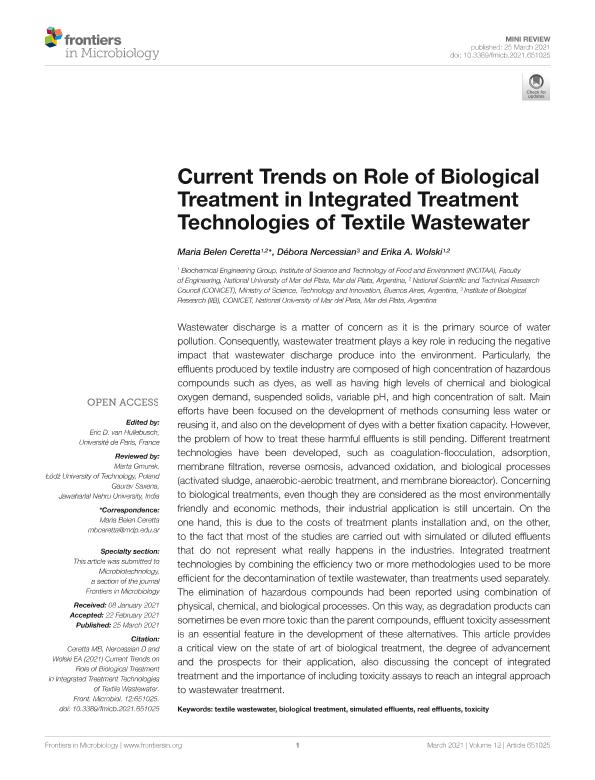Artículo
Current Trends on Role of Biological Treatment in Integrated Treatment Technologies of Textile Wastewater
Fecha de publicación:
02/2021
Editorial:
Frontiers Media
Revista:
Frontiers in Microbiology
ISSN:
1664-302X
Idioma:
Inglés
Tipo de recurso:
Artículo publicado
Clasificación temática:
Resumen
Wastewater discharge is a matter of concern as it is the primary source of water pollution. Consequently, wastewater treatment plays a key role in reducing the negative impact that wastewater discharge produce into the environment. Particularly, the effluents produced by textile industry are composed of high concentration of hazardous compounds such as dyes, as well as having high levels of chemical and biological oxygen demand, suspended solids, variable pH, and high concentration of salt. Main efforts have been focused on the development of methods consuming less water or reusing it, and also on the development of dyes with a better fixation capacity. However, the problem of how to treat these harmful effluents is still pending. Different treatment technologies have been developed, such as coagulation-flocculation, adsorption, membrane filtration, reverse osmosis, advanced oxidation, and biological processes (activated sludge, anaerobic-aerobic treatment, and membrane bioreactor). Concerning to biological treatments, even though they are considered as the most environmentally friendly and economic methods, their industrial application is still uncertain. On the one hand, this is due to the costs of treatment plants installation and, on the other, to the fact that most of the studies are carried out with simulated or diluted effluents that do not represent what really happens in the industries. Integrated treatment technologies by combining the efficiency two or more methodologies used to be more efficient for the decontamination of textile wastewater, than treatments used separately. The elimination of hazardous compounds had been reported using combination of physical, chemical, and biological processes. On this way, as degradation products can sometimes be even more toxic than the parent compounds, effluent toxicity assessment is an essential feature in the development of these alternatives. This article provides a critical view on the state of art of biological treatment, the degree of advancement and the prospects for their application, also discussing the concept of integrated treatment and the importance of including toxicity assays to reach an integral approach to wastewater treatment.
Archivos asociados
Licencia
Identificadores
Colecciones
Articulos(CCT - MAR DEL PLATA)
Articulos de CTRO.CIENTIFICO TECNOL.CONICET - MAR DEL PLATA
Articulos de CTRO.CIENTIFICO TECNOL.CONICET - MAR DEL PLATA
Articulos(IIB)
Articulos de INSTITUTO DE INVESTIGACIONES BIOLOGICAS
Articulos de INSTITUTO DE INVESTIGACIONES BIOLOGICAS
Citación
Ceretta, Maria Belen; Nercessian, Debora; Wolski, Erika Alejandra; Current Trends on Role of Biological Treatment in Integrated Treatment Technologies of Textile Wastewater; Frontiers Media; Frontiers in Microbiology; 12; 2-2021; 1-7
Compartir
Altmétricas




